VALUE
Value Proposition
HEALTHCARE Technology for the healthcare domain
Daily measurements for a more secure, active, and healthy life
Our vocal biomarker technology for the healthcare domain enables visualization of difficult to notice “changes in physical and mental conditions” for the purpose of healthcare (health management) and conditioning (conditioning of the body and mind) through daily voice analysis using smartphones and other electronic devices for daily use. We help you to lead a “more secure, active, and healthy life” through daily measurements.

Providing vocal biomarkers through various collaborations
We provide vocal biomarkers through companies, organizations, health insurance associations, local governments, pharmacies, and nursing care facilities working to create an environment for leading a “more secure, active, and healthy life” (see Medical Domain for the services for medical institutions). We have developed services to make vocal biomarkers available to as many people as possible, including methods of provision, collaboration, and notation, depending on the purpose of use and situation. Through promotion of the wide use of vocal biomarkers, we hope to contribute to “the creation of a society where people can lead a more secure, active, and healthy life.”
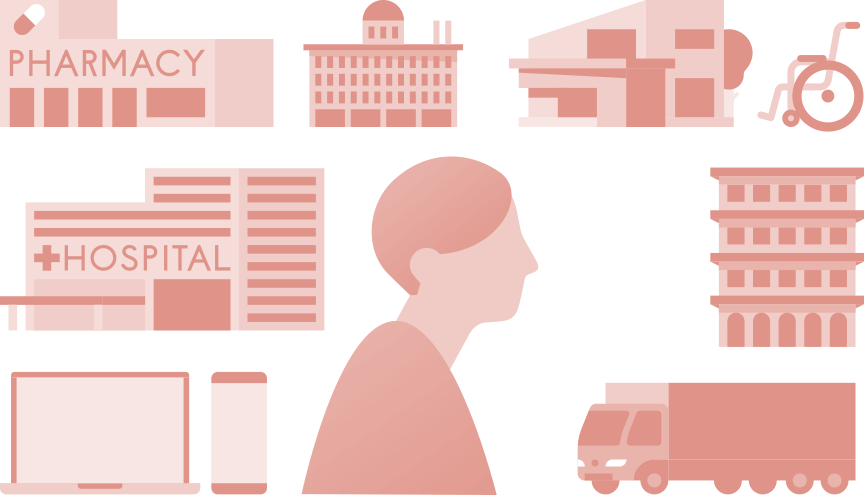
Anticipated application scenarios:
Enterprise:
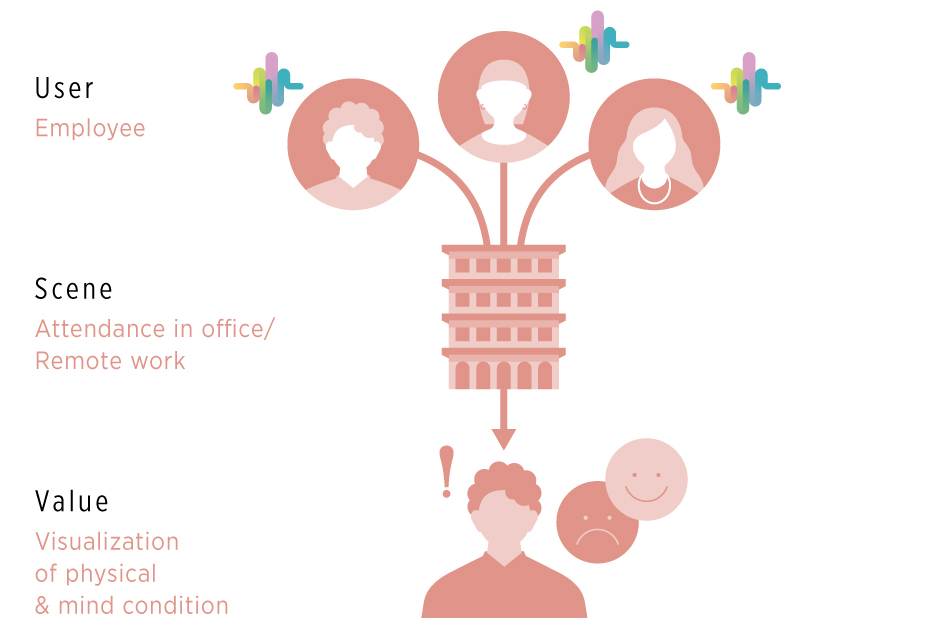
Employee × Vocal Biomarker. The employee’s mind condition can be checked by voice while taking daily work attendance records or by using remote conference tools. The employee or authorized managers and specialists (occupational physicians) can view the data, and appropriate measures such as self-care, line care, and medical care can be taken at an early stage. This can be used for personnel and labor management to reduce the risk of incidents such as administrative leave, resignations, and accidents, and can also be applied to employee welfare services.
Driver Industry:
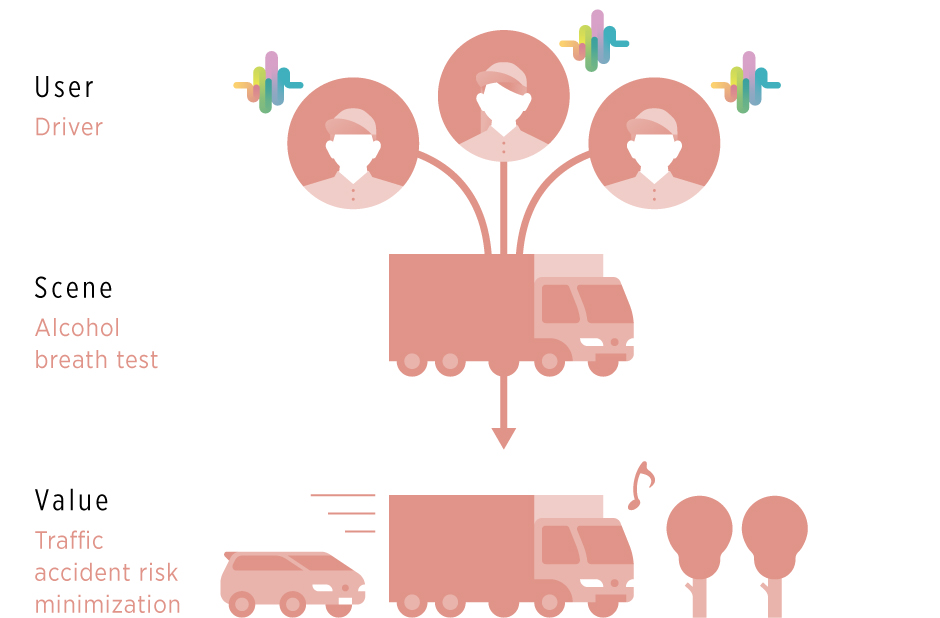
Driver × Vocal Biomarker. The driver’s mind condition can be checked by voice when they record their attendance at work in their daily duties. This can be useful for analyzing trends in the risks of traffic accidents triggered by changes in mind condition. In addition, the system can be viewed by the driver him/herself, as well as authorized managers and specialists (occupational physicians), and can be used as a foothold to take appropriate measures directly related to risk minimization at an early stage.
Nursing Home Care:
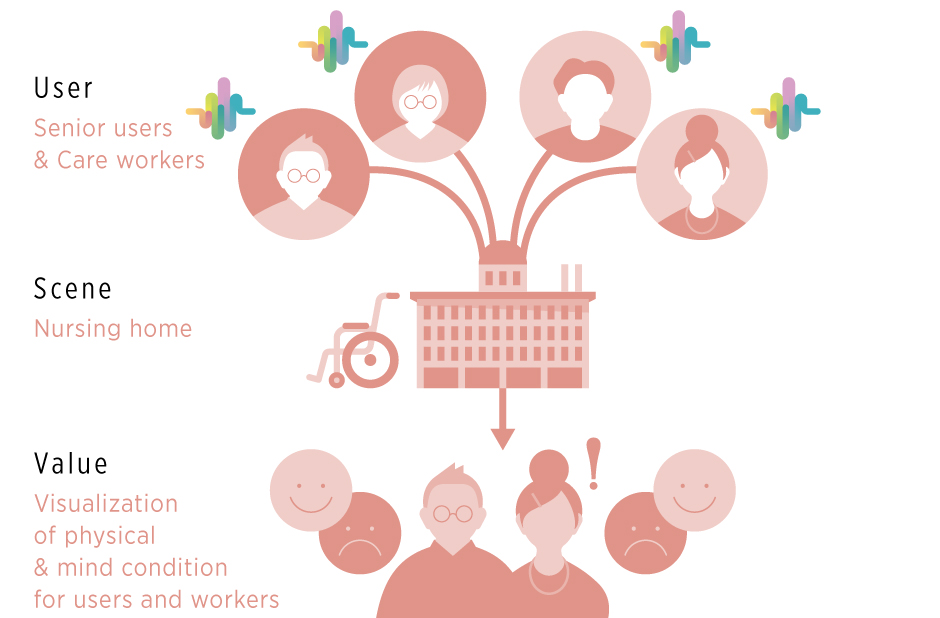
Senior User × Care Worker × Vocal Biomarker. Care workers at nursing homes can take voice measurements of senior users to visualize their mind condition and contribute to the creation of an environment in which residents can relax and live peacefully. In addition, it is also effective in analyzing trends related to the mind and physical condition of not only senior users but also care worker staff members through their own voice measurements for daily self-care.
Pharmacy:
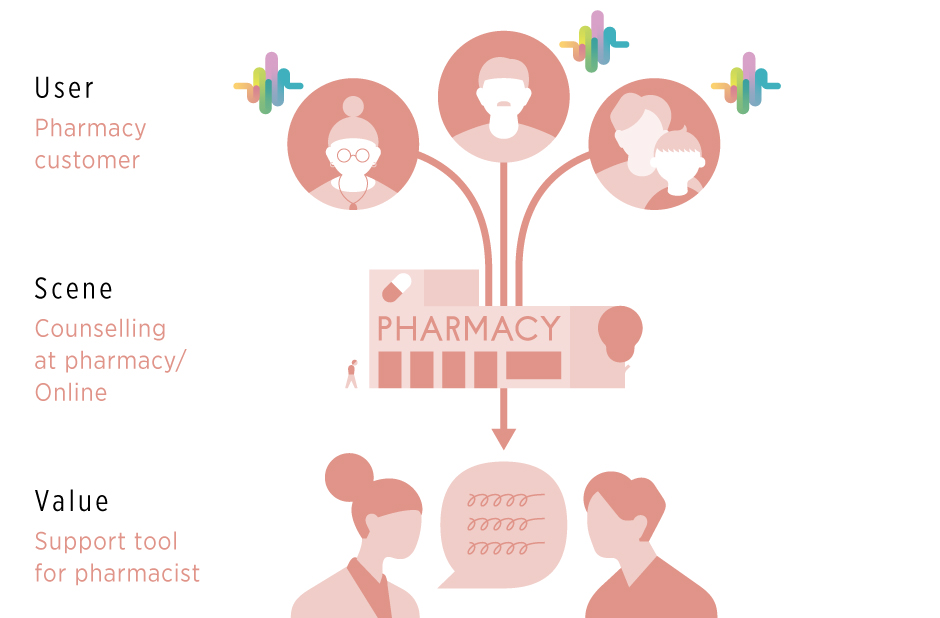
Pharmacist × Vocal Biomarker. By measuring voice at the pharmacy visit, the physical and mind condition can be visualized and used as an auxiliary tool for appropriate health guidance from the pharmacist's standpoint. By providing voice measurements at the time of a patient's visit, the system can be used as a tool to assist the pharmacist in providing appropriate health guidance.
Various types of conditioning
We are aiming for conditioning of the “mind, head, and body” through vocal biomarkers, or voice measurements, on a daily basis.
●Conditioning of the mind
By visualizing “mental condition,” this system can help you maintain a healthy state of mind.
People feel many things, such as joy, sadness, anger, excitement, and relaxation, in their hearts at any given time. We are currently offering technology (MIMOSYS®) that quantifies the “state of mind” as a means of analyzing what people feel in their hearts and visualizing their mental health as a “mental condition.”
MIMOSYS® exports measurement results as “Vitality,” which describes the current state of mind, “Mental Activity,” which shows the trend and flow based on the results over two weeks, and “Mind Index,” which readily represents the mental activity through statistical processing.
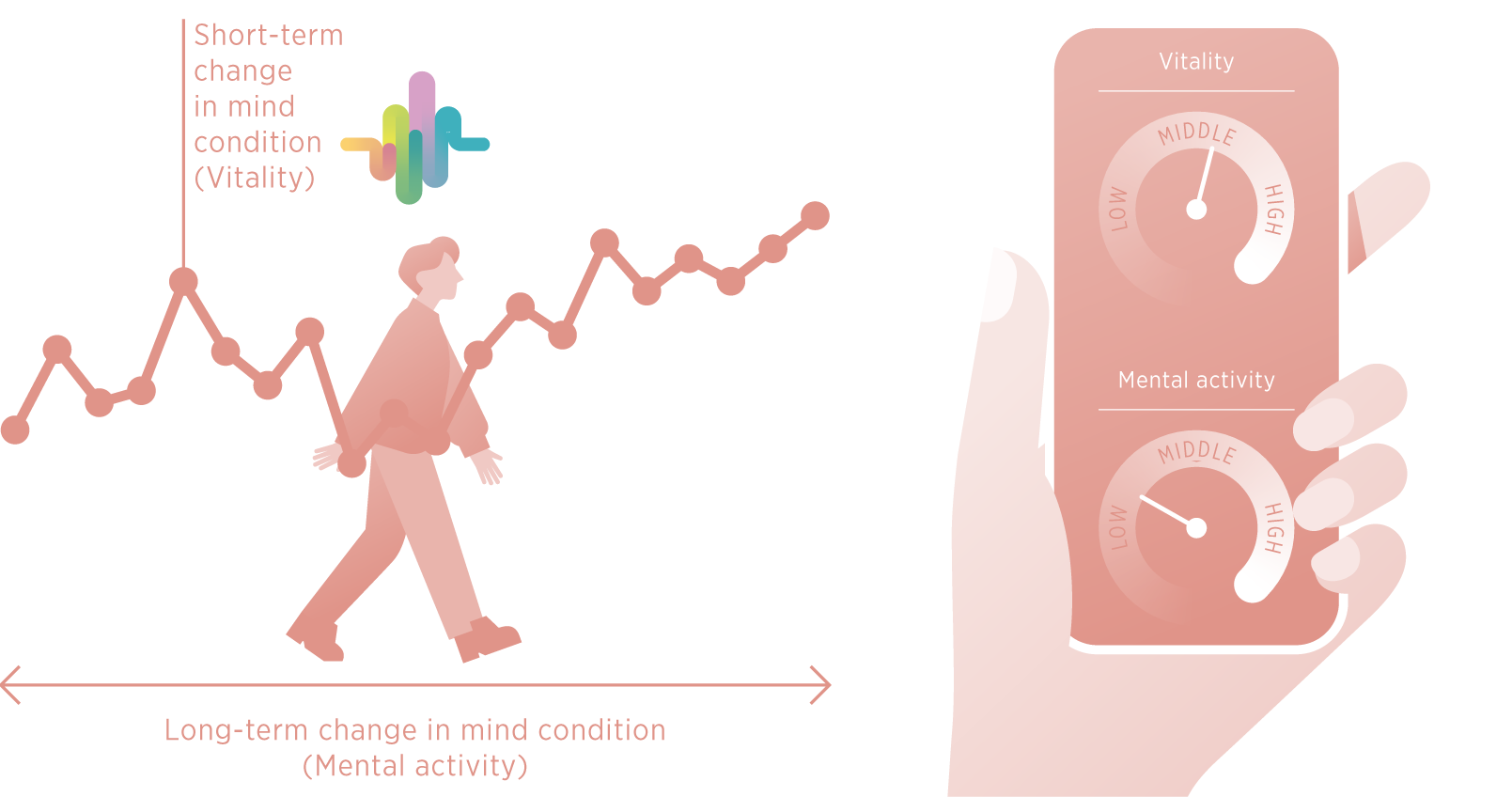
By visualizing the state of mind, which is difficult to notice by yourself, you can cope with various symptoms before they occur or worsen through self-care, for example, by taking a rest or having a change of scene on your own when you are feeling a little down, through mental care by communicating with your friends, colleagues, and family, and through medical care by visiting a medical institution when necessary.
We are aiming to achieve visualization of not only the condition of the mind but also some of the conditions of the head and body from the voice using vocal biomarkers in the future.
●Conditioning of the head (under development)
●Conditioning of the body (under development)
“Blood” sampling and “Voice” sampling
We have proposed blood tests (blood sampling) at annual health checkups or other occasions, and "voice sampling" to measure the voice at key points in your daily life, from the time you get up in the morning to the time you go to bed at night.
By doing so, you will be able to grasp changes in your condition or disorders that are difficult to notice on your own, and you will be able to take conscious action to deal with them before you need to seek medical attention.
We hope to contribute to the improvement of “quality of life (QOL)” through the tone of voice, starting with lifestyle improvement as a self-help effort, self-care to condition your own body and mind, and improvement of self-recovery and resilience.
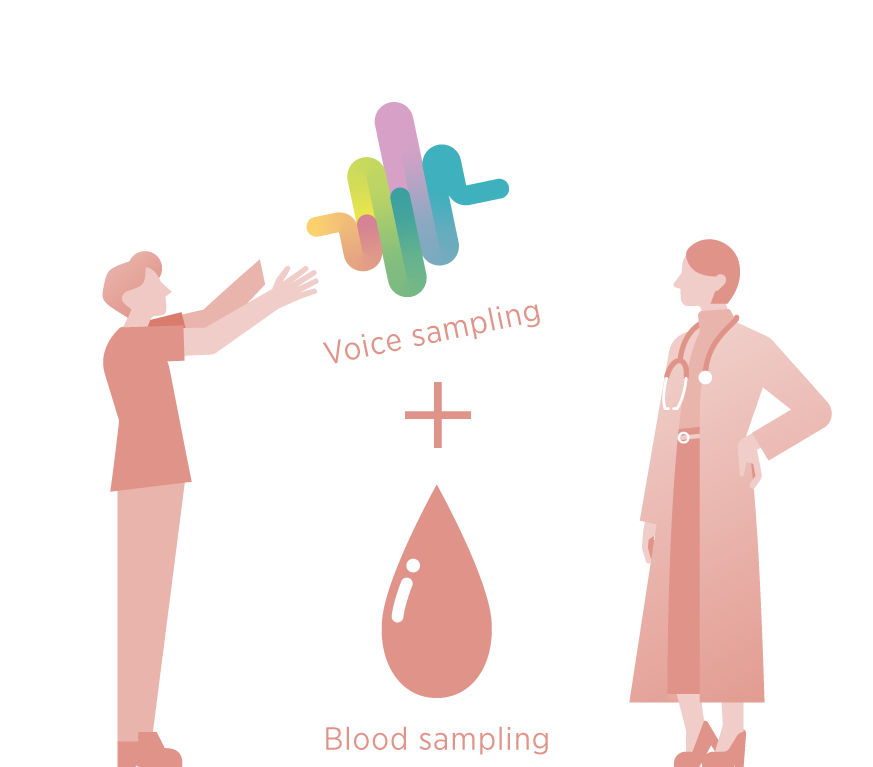
Technology offerings
The following services are available for the use of Vocal Biomarker (vBM) technology for healthcare.
1) Cloud system for OEMs
This service provides, on an OEM basis, front-ends including quickly deployable applications for various vBM technologies, as well as back-ends and a cloud system that can be linked with API.
We offer a package of back-ends including a server, API, and database, and front-ends such as web-based applications for acquiring voice data and displaying results, and management web-based applications for editing various accounts and listing/downloading vBM data.
Based on various accounts hierarchized by granting different authorities, it enables the setting up of various management levels and use of a UI/UX with excellent usability.
As the service is provided on an OEM basis, we have also implemented functions on the front-end so that customers can freely configure their own logos and other settings.
・We provide the following vBMs for healthcare available in the cloud system for OEMs:
1. Conditioning of the mind (MIMOSYS®: Vitality, Mental Activity, Mind Index)
2. Conditioning of the head (under development)
3. Conditioning of the body (under development)
2) WebAPI
This service provides WebAPI that can be used online to implement various vBM technologies in customers’ applications. By posting the acquired voice data to WebAPI, you can acquire arbitrary vBM data. Customers will be required to implement functions for acquiring and creating voice data and to build a database for storing the acquired vBM data by themselves.
・The following vBM data for healthcare can be acquired using WebAPI.
1. Conditioning of the mind (MIMOSYS®: Vitality, Mental Activity, Mind Index)
2. Conditioning of the head (under development)
3. Conditioning of the body (under development)
Case examples in the healthcare domain
PST provides vocal biomarker technology for healthcare to universities, research institutions, and private companies through individual development projects.
Case example 1: NTT Data Japan CorporationBizXaaS® Office (BXO)
Case example 2: Spot Syaroushi-kunSpoMen
Evidence
Neuropsychiatric
Stress
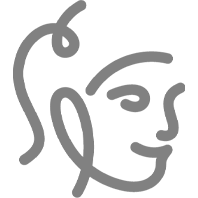
Stress received by the brain is transmitted to the vocal cords via the recurrent (parasympathetic) nerves. The “tone of voice” formed in the resonance cavity can be adjusted voluntarily, but the vibration of the vocal folds cannot be controlled intentionally (involuntary response). Stress and depressive symptoms can be detected by measuring involuntary vocal cord tension (e.g., firmness of the voice) caused by stress or anxiety as a feature.
We are also designing features to measure normal “voice-likeness” (degree of deviation from noise) from speech waveforms. To be specific, we are developing indices to measure the clarity and liveliness of the voice by uniquely quantifying the coarseness and complexity of speech waveforms. Patients with depressive tendencies have decreased values, showing characteristics similar to noise.
- Academic Papers
- 1. How much of an impact did COVID-19 self-isolation measures have on mentalhealth? (Asian Journal of Psychiatry. Dec 2020, Impact Factor:9.5)
( https://www.ncbi.nlm.nih.gov/pmc/articles/PMC7556281/) - 2. Evaluation of emotional arousal level and depression severity using voice-derivedsound pressure change acceleration. (Scientific Reports 2021, Impact Factor:4.6)
( https://www.nature.com/articles/s41598-021-92982-7) - 3. Performance Evaluation of a Voice-Based Depression Assessment SystemConsidering the Number and Type of Input Utterances. (Sensors 2022, Impact Factor:3.9)
( https://www.mdpi.com/1424-8220/22/1/67) - 4. Evaluation of the severity of major depression using a voice index for emotionalarousal. (Sensors 2020, Impact Factor:3.9)
( https://www.ncbi.nlm.nih.gov/pmc/articles/PMC7570922/) - 5. Effectiveness of a Voice-Based Mental Health Evaluation System for Mobile Devices:Prospective Study. (JMIR Formative Research 2020, Impact Factor:2.2)
( https://pubmed.ncbi.nlm.nih.gov/32554367/) - 6. Estimating Depressive Symptom Class from Voice. (International Journal of Environmental Research and Public Health, 2021 ImpactFactor:4.614)
( https://www.ncbi.nlm.nih.gov/pmc/articles/PMC10002315/)
- Conference Presentations
- ・Study on Indicators for Depression in the Elderly Using Voice and Attribute Information, (Information and Communication Technologies for Ageing Well and e-Health, 14 June 2018, ICT4AWE 2017 Conference paper)
(https://link.springer.com/chapter/10.1007/978-3-319-93644-4_7)









